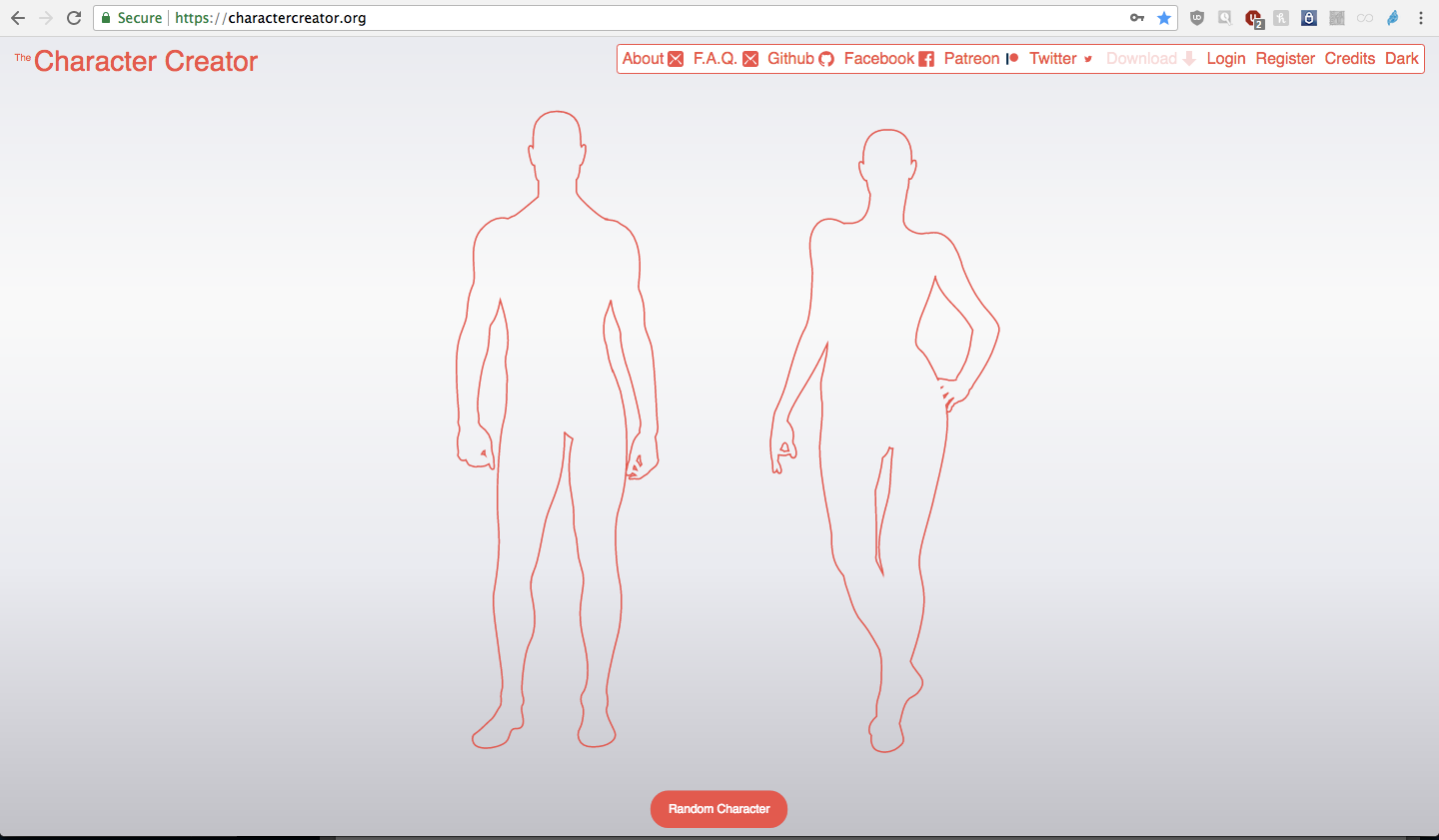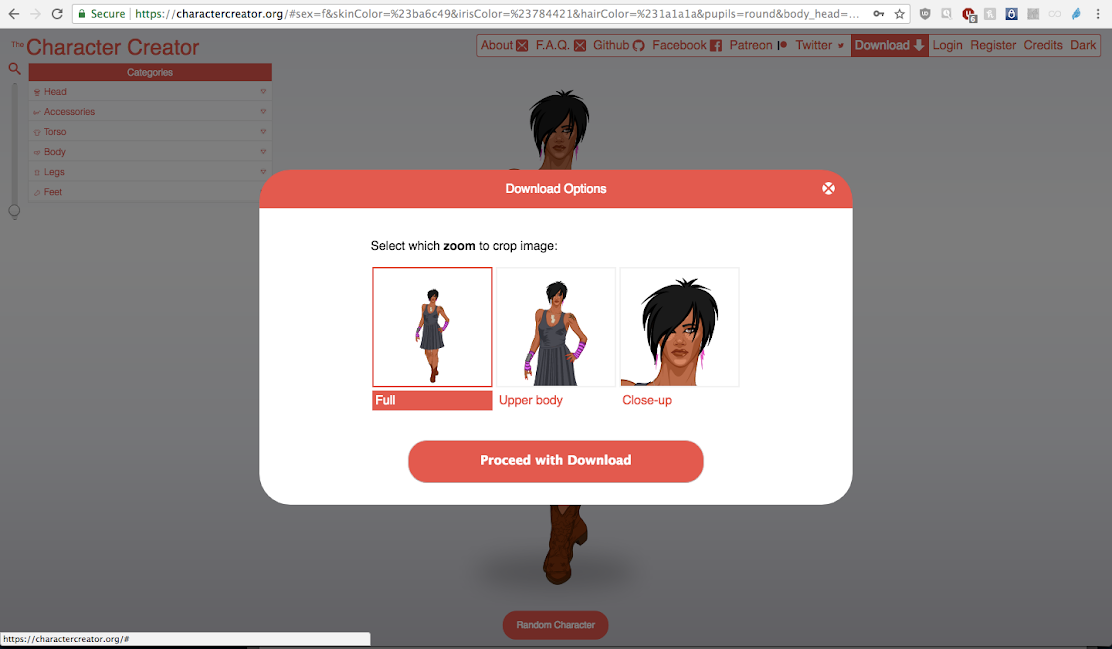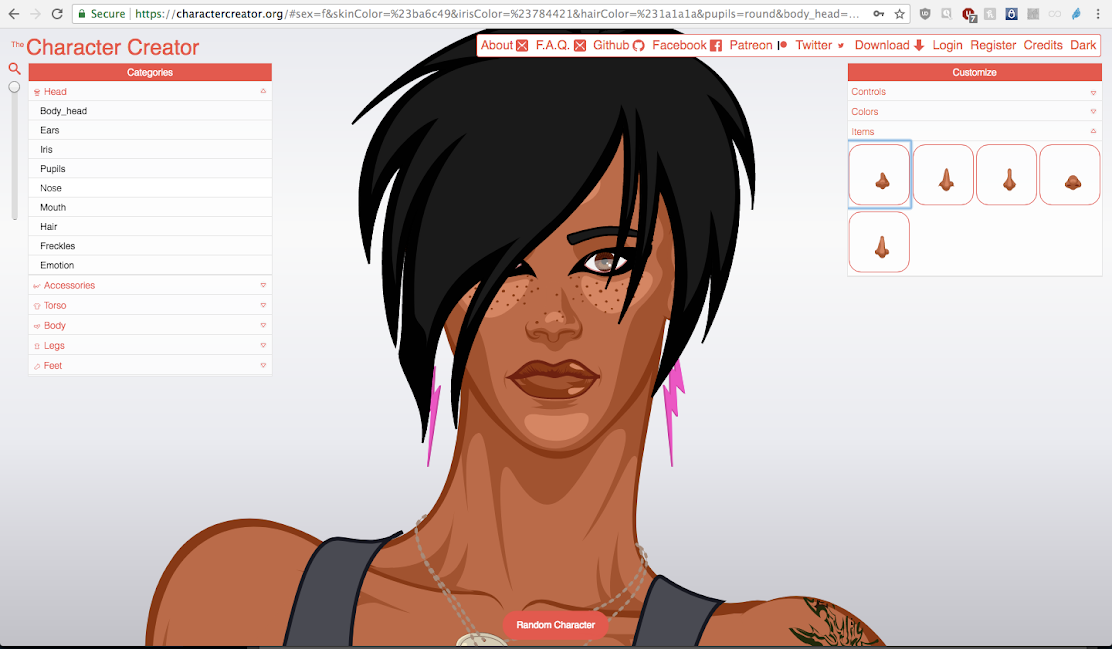An Interview with Frederic Guimont of The Character Creator
Hello! What's your background, and what are you working on?
My name is Frederic and I'm a comic book artist and web developer. I grew up programming on the family computer and making comics at my drawing table. I worked as a comic book penciler for a while, and eventually became a web developer along the way. Those two skills ended up mashing together, which is how I came up with The Character Creator.
The Character Creator is a web application that helps storytellers visualize their characters in a consistent, realistic, hand-drawn style. Just click through a series of options and menus and build your character according to your choices. It also has a download button so you can save a copy of the vector file on your storage device.
I built The Character Creator to help me improve the character creation process to make it faster and easier. As a developer, I could see the benefits of reusing code, but as an artist there was no sophisticated way to do that.

Every time a comic book artist draws a new panel, they're starting from scratch. By switching to vector art as a medium and treating the characters as bits of code, I was able to categorize all the elements that make up a character and reuse them in a modular way each time I need them as a part of a new character. Every item is then drawn only once and becomes available to all.
Another nice thing about organizing these drawings is that you can then design an algorithm to assist in the creation of original, random characters from a vast selection of these elements. These random characters can often be surprising and inspire stories just from the initial impression it leaves us with.
What motivated you to get started with The Character Creator?
I was working on a comic book project that was starting to get out of hand. I had approached that project in the most interesting way I could imagine... but this also meant it was done in the most complicated way possible. It would eventually wear me out and slow the project to a grind. That pain point got me to look for a better way to do things.
At that time, I had switched my software for Linux and started playing around with free graphics programs when I found Inkscape, a vector graphics program. It made me rediscover vector graphics. I had played around with this format years ago in school, but back then it didn't interest me like it does now.
The properties of Scalable Vector Graphics (SVG) made it abundantly clear to me that this was the medium with which I could try out and test my theory.
I had to learn to code in JavaScript in order to be able to build the application as I'd pictured it. At first I used every library I could think of and asked friends for help to get a minimum viable product up and running.
I used Snap.svg and jQuery and even D3 at some point. But it was just a quick and easy way to get a version up and running and have something that people could give us feedback on, starting the first of many iterations of the product. With time though, I opted to remove all libraries and replace all the use cases in my project with custom functions. I had to refactor parts of the codebase two or three times, but each iteration has been an improvement. There's still room to improve today.
The site received a few visitors in the beginning, but it tapered off pretty quickly. I updated the site whenever I could, with varying intensity through these last six years. I worked on bug fixes and adding all the features on the roadmap and figuring out what order I was going to do it in.
It wasn't until three years later that traffic started to increase organically. People started to find it and take an interest enough to spend time creating a character of their own. The inventory of items available to choose from had to reach a critical mass to make the game-like interface appealing and immersive.
I never gave any thought to an alternative. It was always about laying the groundwork so I could get to the good stuff as soon as possible. The character creation process is what has interested me the most in the project, and it was the problem I just couldn't stop thinking about. I also felt I had the skills to bring it to fruition.
My financial situation at the moment resembles that of an artist. I'm not yet ramen profitable, but am in the middle of negotiating a contract that could change that in the short term. hopefully it'll work out and we'll start growing the team... or perhaps it won't and we'll keep bootstrapping until we find the next opportunity!
What went into building the initial product?
I designed the project to be as lightweight as possible. In terms of the code, but also the costs it takes to keep it going. There's essentially no burn rate ($20 a month server cost) other than my basic cost of living.
I did this intentionally so the project wouldn't be hindered for lack of funds. I taught myself JavaScript, CSS, and vector graphics on the web. I took it one step at a time as I built up the parts that made up the application. Six years later and I still feel like I'm only getting started.

I wanted the UX to be as great as I could possibly make it. So I broke it down into all the steps in took to create an original character. From the initial page load, a pair of silhouettes are drawn on the screen. You click on the one you want. From that very first click on the site, you instantly find yourself in the character creation process. From there, I focus on keeping the same level of user experience all the way to end when the user chooses to download their creation.
It took about four years worth of coding spread over six years of varied jobs in IT. The codebase was partly refactored at least three times in order to improve the performance and meet coding standards. At each step I would add a new feature, usually the most urgent or important one at the time, with some more important ones taking over a year to get all the art and code ready so the new feature is complete.
I had to make a decision at the beginning to limit the application to just one body type for each sex, but that's only for now. I plan on adding more body types as the team grows. It's on the roadmap... but don't ask me for a delivery date yet!
The funding comes from my day job when I'm working and from my savings when I'm not. Today I earn a little bit from Patreon, a little from ads, and some custom drawing and coding, which allows me to work on it full time.
I have friends who've helped me greatly in the beginning by coding features I couldn't figure out on my own. Some friends continue to contribute and help me out. A close friend, Robin Millette has helped me in designing a lightweight back end for the MVP so it could be up and running in record time. Another friend, Maxim St-Hilaire is a pro with digital marketing and has given me good advice on how to improve the traffic of the site.
What's your tech stack?
Everything in this project revolves around displaying SVG in the most convenient way possible. I use HTML because SVG is an integral part of it. I use JavaScript because it's the programming language of the web browsers today. Simple, efficient.
The back end is an instance of CouchDB on a GNU/Linux virtual machine serving the site with Caddy 2.0.
The codebase has improved over time as my experience. One of the biggest changes was the removal of all but one library, in order to improve the overall weight of the project, and also to keep the load time as fast as possible.
The biggest technical challenge I found along the way (and there were many) was how to get the application to load the SVG from the server and get it into the browser and on the page. That took me a long time to figure out all the ins and outs and I have spent a lot of time on forums and talking to friends about this problem before it was resolved.
How have you attracted users and grown The Character Creator?
I didn't have much of a launch at first. I simply announced it on twitter mid-January 2014. Some people got angry about the differences between the two sexes (they didn't have all the same items then, they still don't today.) Soon after this soft launch, the attention died down. It took about three quiet years to build it into a solid product that could garner and keep people's interest.
Even though I had been working on it for years, the gradual influx of traffic still caught me by surprise. It was the sudden interest that prompted me to get new features added to allow users to save their creations and come back to them later for further editing. My friend Robin and I started building a way to register users and allow them to upload characters on the site after saving them to the cloud. This would make the app more than a one-time playful gimmick and more of a hub of creativity for the users.
Data points:
- record for most visits on a single day is may 18th at 9,525 Users
- 213,133 users within the last 30 days
- 1,594,388 users within the last year
- 152.33% increase from the year before
- 2.4 million users in the last 3 years
- Average session duration is 5:03 minutes
- Users who stay over 1 minute, stay an average of 9:43 minutes
Since the first proof of concept version of the site, most of my efforts went into improving the user experience. The rest has been to add content in the form of new items of clothing and accessories for both the male and female templates.
If I had a marketing budget it would all go into improving the product. When a product is great, people talk about it and that beats any other form of advertising you can buy. I always focus on making the character creation process better.
I do keep my social media accounts active, mostly by posting new items that are added to the application as they come.
I tried using a mailing list a few years back but I didn't have much luck with it. The service I was using charged according to the size of your list, regardless of how many emails you send out each month, so as my list grew, the price to keep the service took a toll on the project which wasn't earning any revenue at the time.
My growth strategy begins with using keywords in my domain name, making sure the site was responsive and that the text content was accessible to search engines. That and putting 90% of the work into the first 10 seconds of the user experience.
What's your business model, and how have you grown your revenue?
I'm still exploring the business model. I have a Patreon page, I do art and code on-demand and display ads on the site. The project isn't ramen profitable yet, but I see it growing steadily. I feel like it could take off any day, but I'm ready to keep it going even if it doesn't.
"Build your project as lean as possible in the beginning so that it doesn't burn the runway too fast."
Revenue comes with traffic and that grows a lot depending on how much sustained effort I put on the site.
I don't use a payment system other than going through Patreon for subscribers and Paypal for contract work.
The biggest change in revenue so far was when I added ads to the site. It was recommended to me on an Indie Hackers thread, and I was also approached by a company that provides display ads. This is the most recurring passive income I've had so far. It gave me a new level of confidence in what can be achieved with time and given the right effort.
What are your goals for the future?
I have an idea of the different features I want to add to the site. It's not a formal roadmap but it might as well be. I want to continue to improve the character creation process and add features to manage them in relation to each other as part of a cast of characters. I see a whole connected version of The Character Creator where you will be able to share your character with other creators and build on each other's stories.
In terms of the project finances, I'm trying to avoid getting into debt with this project. That's why I only spend what comes in as revenue, otherwise I keep the project going solo. When the revenue increases, I'll start to grow the team to have more frequent updates for features, bug fixes and new items, as well as bring in much requested features such as a variety of body types, postures and action poses.
I think the biggest roadblock right now is trying to increase the revenue to the point where I can attain ramen profitability and look forward to growing the team organically.
What are the biggest challenges you've faced and obstacles you've overcome?
The greatest challenge is balancing a day job and a side project that's gaining traction, especially when it's still in the pre-revenue stage. I've always tried to save up so I can live a modest life for a while, so I can have more time between jobs where I focus full time on the project.

The best lesson I've learned is to build a project as lean as possible in the beginning so that it doesn't burn the runway too fast. By doing everything myself since the start, I had to really stop and think of what it should look like and how it should function. I had especially learned a lot from a previous project where everything was over-complicated.
Have you found anything particularly helpful or advantageous?
The best decision I made was to follow the lean method, start early, and iterate often. As soon as I had a prototype it was available online and I announced it on twitter. From there I kept improving on it over six years. The project gained traction earlier than I expected it to; I would have never gained any of that traffic if I didn't publicly share my prototype from early on.
A habit I picked up from other artists is collecting pictures of people and things I like. I keep them organized in folders and use them to inspire new clothing and accessories, new expressions and action poses.
"Work on your next product, don't make excuses."
One thing that helped a lot was a post I made on Indie Hackers. Not knowing how to improve my income at the time, I posted a question on the board and a lot of people recommended I include ads on the site. I approached the one that came the most recommended among the replies to my post. They weren't super interested but still open to try it out, but just before commiting I was approached by another advertising company that had a better offer. That gave me a new source of recurring passive income.
It wasn't so much the amount as much as the fact that I could count on it for a while. I felt a shift in the way I perceived the future, it gave me confidence and it made the project feel more real in a weird way. From then on I believed a lot more in the financial success in the project.
What's your advice for indie hackers who are just starting out?
Work on your next product, don't make excuses. If you have something great, people will flock to it. Just keep improving your idea until it gets other people excited.
People often make the mistake of thinking visitors will magically be interested in their thing. You have to present that thing in its most favorable light and make the experience of purchasing it a pleasant one. Something that will make you want to experience it again.
Where can we go to learn more?
Go to The Character Creator and create your first character!
I always ask people: what's an item I don't yet have that absolutely needs to be included?
Happy to answer any questions in the comments on the site!